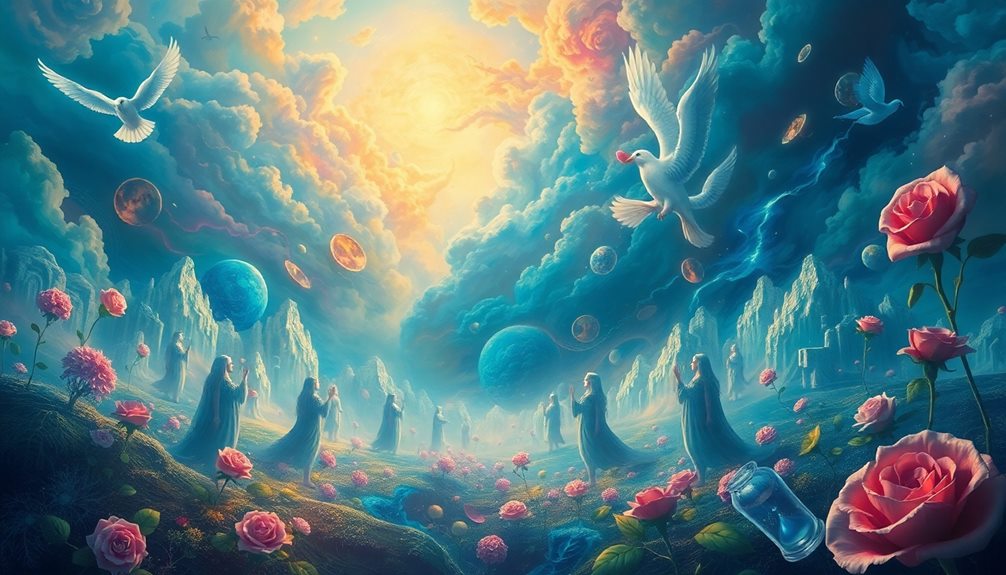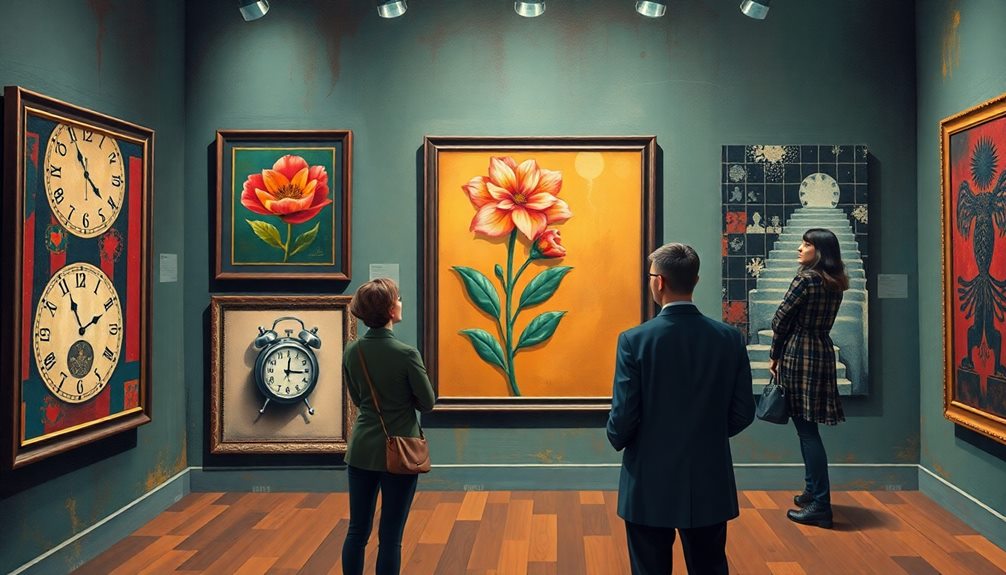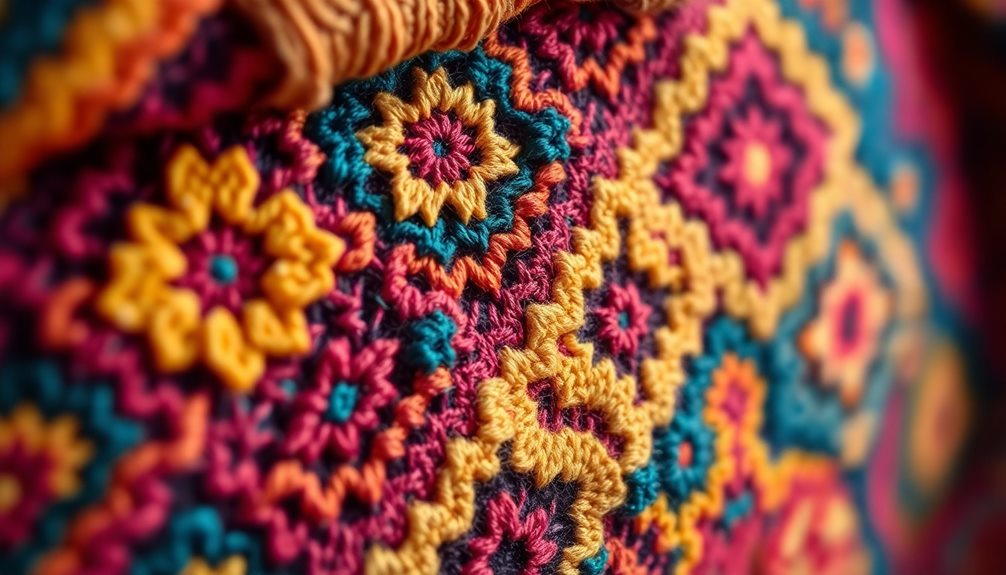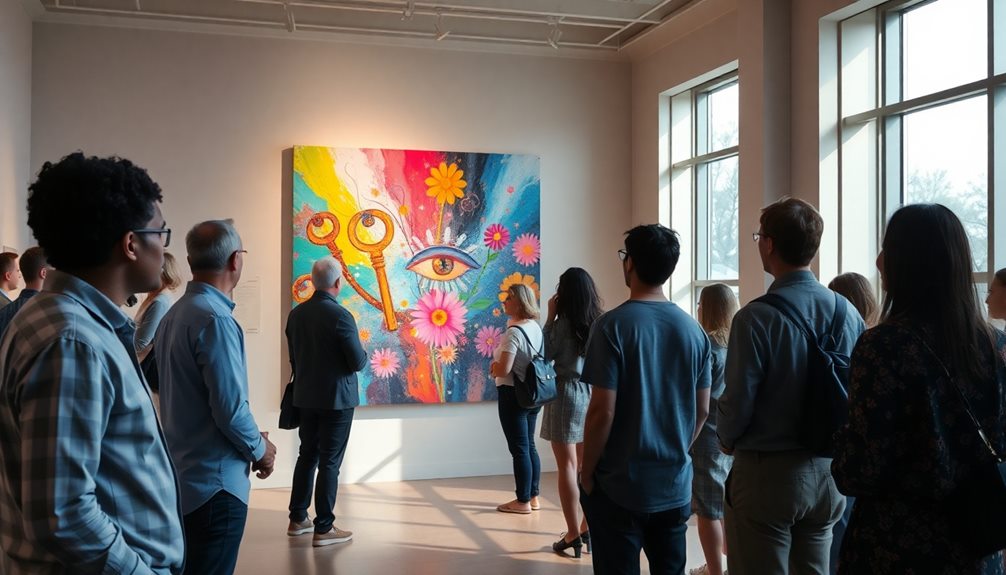To interpret symbolism in artwork, focus on the emotions and deeper meanings conveyed by the artist. Each symbol often carries personal significance and can vary widely in interpretation. Look for recognizable forms that might evoke familiar feelings, complemented by specific colors that enhance mood—like blue for calm or red for passion. Artists like Klimt and Munch used these techniques to explore profound themes such as love or existential angst. By considering the historical and cultural context, you can uncover richer insights and appreciate the emotional layers in art. Continue exploring to enhance your understanding of these enchanting nuances.
Key Takeaways
- Understand that Symbolism prioritizes emotional expression over realistic representation, inviting personal interpretations of artwork.
- Recognize that colors play a crucial role, with specific hues evoking distinct feelings and enhancing symbolic meanings.
- Analyze the use of recognizable forms alongside dreamlike imagery, which allows for deeper exploration of emotional landscapes.
- Consider the historical and cultural context, as it informs the meanings and significance of symbols within the artwork.
- Reflect on the artist's intent and personal experiences, as these shape the integration of symbols and their emotional impact.
Understanding Symbolism in Art

Exploring the world of Symbolism in art reveals a fascinating departure from the constraints of realism and naturalism. Instead of depicting the physical world, Symbolist artists like Gustav Klimt and Edvard Munch create a visual language that evokes emotions and suggests deeper meanings. By using recognizable forms and muted colors, they investigate complex themes such as love, death, and spirituality, inviting you to engage with their works on an emotional level.
Understanding symbolism in art requires you to look beyond the surface. Each symbol carries specific meanings that are often deeply personal to the artist, making your interpretation unique. Unlike more universal themes found in other art movements, Symbolism focuses on the subjective experience, emphasizing the thoughts and sensations that arise from the artwork.
As you explore these dreamlike images and allegorical themes, you'll discover how color and form can convey emotions that reflect the human experience. Recognizing these symbols and their meanings allows you to appreciate the rich tapestry of ideas that Symbolist artists sought to express.
Key Characteristics of Symbolist Art

Symbolist art stands out for its unique blend of recognizable forms and dreamlike imagery, inviting viewers to explore a world of emotion and meaning. This movement emphasizes a deeper connection to life's larger themes, using symbolism to convey complex ideas rather than just emotions.
Here are four key characteristics of Symbolist art:
- Recognizable Forms: While it incorporates dreamlike imagery, you'll notice that Symbolist art often maintains identifiable shapes, allowing for personal interpretation.
- Muted Colors: The use of subdued color palettes creates an atmosphere of introspection and mystery, enhancing the artwork's emotional depth.
- Mythological Elements: Artists frequently draw from classical influences, weaving mythological and spiritual themes into their work, which adds layers of symbolic meaning.
- Distorted Figures: Expect to see figures that may appear altered or exaggerated, evoking a sense of the fantastical, and prompting you to investigate deeper into their implications.
Through these characteristics, Symbolist art distinguishes itself from other movements, guiding you to engage with its profound meaning and explore the emotional landscapes it portrays.
Influential Symbolist Artists

Several influential artists shaped the Symbolist movement, each contributing unique perspectives and techniques that enriched its emotional and thematic complexity.
Gustave Klimt, for instance, is renowned for his sensual subjects and innovative use of gold foil. His iconic work, *The Kiss*, exemplifies the emotional depth typical of Symbolist art, where he masterfully used symbols to convey intimacy and connection.
Edvard Munch explored darker themes like death and human struggle, with *The Scream* serving as a powerful representation of existential angst and emotional turmoil, reacting against realism to explore deeper psychological states.
Odilon Redon focused on dreams and fantasy, often drawing inspiration from literature; his work *Pegasus* reflects a fascination with the subconscious and surreal imagery.
Gustave Moreau, celebrated for intricate compositions, often incorporated mythological themes, as seen in *Oedipus and the Sphinx*, highlighting the Symbolist emphasis on allegory and emotional expression.
Analyzing Symbols in Context

Understanding the rich tapestry of symbols in artwork requires a keen eye for the cultural and historical contexts surrounding each piece. The meaning of symbols can shift dramatically based on various factors, reminding us that art isn't created in a vacuum.
For instance, the cross in Western art often signifies Christianity, while in other societies, it may represent the four cardinal points. This diversity illustrates how symbols can be layered with meanings.
When analyzing symbols, consider these key points:
- Cultural Significance: Symbols often depict beliefs and values of a specific culture.
- Historical Context: Understanding when a piece was created can reveal reactions against realism and naturalism.
- Artist's Intent: Artists' personal experiences shape how symbols are integrated into their work.
- Emotional Impact: Symbolist art, for example, often employs symbols to evoke emotions and suggest deeper realities.
The Role of Color in Symbolism

Color plays an essential role in conveying emotion and meaning in artwork, particularly in Symbolism. By using specific hues, artists can spark the viewers' emotions and invite them to explore deeper themes. For instance, blue often symbolizes calmness and truth, while red conveys passion and strength. In Gustav Klimt's *The Kiss*, the use of gold creates an opulent atmosphere, enhancing the sensuality of the subjects.
Symbolist artists like Edvard Munch utilized contrasting colors in works such as *The Scream* to illustrate despair and anxiety, emphasizing the emotional turmoil of the human experience. Green frequently represents nature and life, highlighting growth and vibrancy, which resonates with themes of renewal and the cyclical nature of existence.
The interplay of light and shadow, along with the carefully chosen color palette, contributes to the dreamlike qualities of these compositions. Each color's cultural and psychological meanings enrich the viewer's understanding, bridging the gap between the physical world and the emotional landscape.
As you engage with these pieces, remember that every choice made by the artist serves a purpose, allowing you to appreciate the layers of meaning within the oil on canvas. Rights reserved.
Frequently Asked Questions
How to Understand Symbolism in Art?
To understand symbolism in art, you'll want to explore historical context, analyze colors and motifs, and consider the emotional tone. Look into the artist's background, as their intentions often reveal deeper meanings behind the symbols.
What Are Examples of Symbolism in Art?
You can find symbolism in various artworks. For instance, Klimt's gold leaf in *The Kiss* represents love, while Munch's vibrant colors in *The Scream* convey emotional turmoil, showcasing the depth of human experiences.
What Is Reading Symbolism?
When you read symbolism, you decode hidden meanings behind images and objects. It's like deciphering an ancient text, revealing deeper insights and emotions that enrich your understanding of the artist's intent and cultural context.
What Is the Study of Symbolism in Art?
The study of symbolism in art explores how artists convey deeper meanings through symbols. You'll analyze images, consider cultural contexts, and uncover emotional responses, revealing personal and universal interpretations that enrich your understanding of their work.
Conclusion
To sum up, diving into symbolism in art enriches your appreciation and understanding of the piece. For example, consider Edvard Munch's "The Scream." The swirling colors and distorted figure symbolize existential dread and anxiety. By recognizing these symbols, you connect more deeply with the emotions behind the artwork. So next time you view a piece, look beyond the surface—each brushstroke might tell a story waiting for you to uncover!









